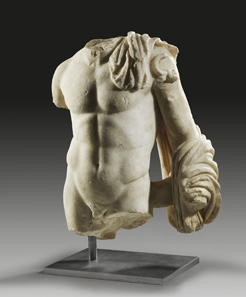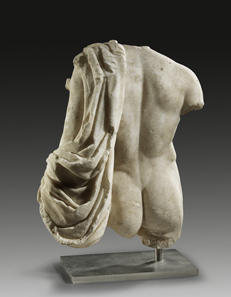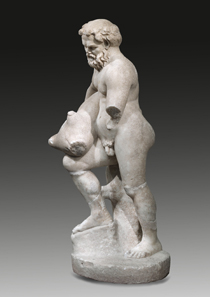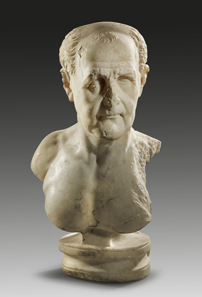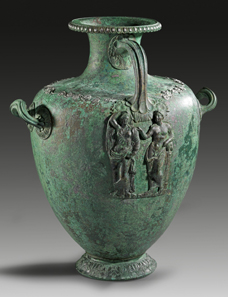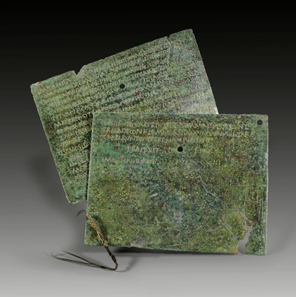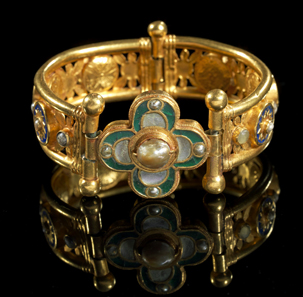17-12-2013 – 01-01-1970
Auction sale 218: Ancient Art
Precious objects from ancient times at Gorny & Mosch
It has become something of a tradition that collectors of ancient art meet at Gorny & Mosch in December. The international auction house presents an accompanying catalog this year as well that is highly likely to arouse much attention. The objects listed in the first part of the auction will surely attract wide interest. But the more ‘ordinary’ collector won’t miss out, too, for he will find single lots starting as low as 250 euros and a large selection of reasonably assembled multiple lots in addition.
1: Torso of Hermes. White, finely crystalline marble. H 45 cm. Roman Imperial Period, 1st-2nd cent. AD. Estimate: 40,000 euros.
The sale’s highlight could become a marble torso of Hermes. The wonderful object made of white, crystalline marble is slightly under life-size and should refer to a Greek original of the late Classic period whose type is known as “Hermes Richelieu”. The estimate is 40.000 Euro – and due to its beauty this might not be the last offer by far.
Anyone more fond of a torso made of bronze will find the right thing at Gorny & Mosch, too: lot 15 is a larger-than-life bronze torso from the 1st to the 2nd cent. A. D. that is estimated at 75,000 euros.
3: Silenus. White, finely crystalline marble. H. 115 cm. Roman Imperial Period, 1st cent. AD. Maria Ortmeier Collection, Linz. Estimate: 250,000 euros.
To 250.000 Euro amounts the estimate of a Silenus who is holding a wineskin. The statue was used in antiquity as fountain figure. Then, water poured out of the spout of the container.
5: Portrait bust of an aged Roman. Trajanic, 1st quarter of 1st cent. A. D. White, finely crystalline marble. H. 59 cm. Estimate: 90,000 euros.
Likewise remarkable is a portrait bust of an aged Roman that stands in the tradition of late Republican likenesses, even though the present bust dates to Trajanic times. The head full of character depicts a tradition-conscious Roman who was proud of his life experience and his sobriety and who wanted these very traits, as embodiment of his ‘gravitas’, expressed in his bust. The impressive portrait is estimated at 90,000 euros. Only a fraction of that sum, i.e. 20,000 euros, is expected for a head of Emperor Nero dating to his final reigning years. It comes from the Pacha Bank, Coventry, and was part of a British collection before that.
36: Bronze hydria. Greek, 4th cent. B. C. H 47.5 cm. Estimate: 175,000 euros.
From the stock of the company Furneux “Ancient and Medieval Art”, which seized to exist in 1990, comes a bronze hydria from the 4th century B. C. This gorgeous piece, lavishly decorated with silver inlays and figural representations, is estimated at 175,000 euros.
33: Roman military diploma of a praetorian. Hadrianic, A. D. 119. Estimate: 15,000 euros.
Of great historical interest is the Roman military diploma of a praetorian dating to A. D. 119. While ordinary military diplomas usually include an acknowledgement of the Roman civil right and / or the right to enter matrimony, this diploma exclusively deals with the conubium since a praetorian had to possess the civil right in order to be accepted into that elite troop in the first place. The estimate of that interesting piece, whose interiors are clearly readable, reads 15,000 euros.
72: Pair of gold bracelets with lapis lazuli, beads and glass. Eastern Mediterranean region, early Byzantine, 5th-7th cent. A. D. 69.79 g and 67.05 g; Dm 6.3 and 6.5 cm. Estimate: 100,000 euros.
In case anyone is looking for a unique Christmas present he (or she) should have a look at auction sale nr. 72 that comprises a pair of early Byzantine gold bracelets with lapis lazuli, beads and glass inlays from the 5th to the 7th centuries A. D. Their styling indicates that they were produced in a workshop that worked on behalf of the imperial court. The mosaics of the church San Vitale in Ravenna depict a gentlewoman who wears jewelry on her arms that bears close resemblance to the ones presented here. 100,000 euros is the estimate of these wonderful works of art.
But of course you don’t have to spend that much money to acquire ancient jewelry as a possible Christmas gift. With just 300 euros you can take part in the bidding for an Egyptian bead necklace from the Third Intermediate Period (1085-713 B. C.) that is decorated with seven Eyes of Horus. From a German private collection comes a badge with the Macedonian Star that became such big an apple of discord between Greece and Macedonia. A silver disc from the 4th cent. B. C. with a depiction of that star can be acquired at Gorny & Mosch for at least 250 euros. 300 euros is the estimate of a real gem, an intact skyphos from Magna Graecia, made in the late 4th cent. B. C. It comes from the collection of Dr K.-L., Berlin.
Almost 70 lots comprising Egyptian art are of interest to the special collector.
In this brief auction preview we mustn’t omit the more than 110 intriguing multiple lots offered by Gorny & Mosch. Reasonably assembled objects at extremely attractive prices invite the collector to attend the viewing and to place a bid in the auction.
The catalog can be viewed on the internet.
Gorny & Mosch will be happy to send you a catalog as well. Request it at Gorny & Mosch, Giessener Münzhandlung, Maximiliansplatz 20, D-80333 Munich, phone +49 / (0)89 / 24 22 643-0, fax +49 / (0)89 / 22 85 513. The next auction sale “Ancient Art” is scheduled for June 2014. Consignments will be accepted until March 2014.




